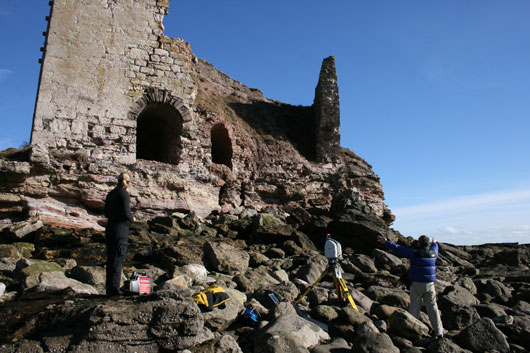Experts call for ‘citizen archaeologists’ to help save Scottish coastlines

It is hoped that public-spirited volunteers will offer their support to saving the potential destruction of more than 940 sites of historic importance around the country.
But instead of taking to horseback, all keen archaeologists will need is a mobile phone or camera.
Led by archaeologists from the University of St Andrews and SCAPE (Scottish Coastal Archaeology and the Problem of Erosion) the Scotland’s Coastal Heritage at Risk Project will be launched at an event in Edinburgh today (Monday 13 August 2012).
Archaeologist Tom Dawson, who leads the University of St Andrews’ role in the project, explained, “There are over 940 priority sites around Scotland’s threatened coast that we want the public to help us build up a better, more current picture of. We really need to update our information on all the priority sites as some of them may have been destroyed since they were first recorded.”
Amongst the sites up for investigation are Stenness Fishing Station in Shetland, the Iron Age site at Hodgalee in Orkney and the Pile Lighthouse in the Tay.
The first stage of the project involves ‘crowd sourcing’, where members of the public are asked to provide information on those coastal heritage sites threatened by erosion. ‘Citizen archaeologists’ can either upload current images to the web or directly via a free mobile phone app, which will also log the location of sites via GPS.
Mr Dawson continued, “We want people to tell us which sites they think are deserving of further work, whether that be excavation, making interpretation boards or recording through computer modelling. We also want to hear about new sites that have been discovered due to erosion.”
The second stage of the study will bring together heritage professionals and members of local groups to work at sites with the best recommendations. Projects will take place at twelve sites from around the country.
Those without a smart phone can also take part by recording the information via the project’s interactive website. Training sessions, as well as online resources, will be provided to volunteers around the country.
The project is funded by the Heritage Lottery Fund, Historic Scotland, the Crown Estate and the University of St Andrews.
The Head of HLF Scotland, Colin McLean, commented, “Scotland has some of the most stunning coastline in the world and our natural environment plays a key role in our sense of national identity and pride. Our coastline is not only beautiful, but is also populated by sites of archaeological importance, which are now under threat from wind and waves.
“Our grant will allow teams of local people from coastal communities to monitor the impact of erosion on these coastal sites across Scotland and record their historical importance before they are lost forever.
“Through this fascinating project countless volunteers, including many young people, will learn new skills as they discover more about the intrinsic links between their natural surroundings and our nation’s history and heritage.”
The project builds upon coastal surveys and a prioritisation project already undertaken by SCAPE / University of St Andrews’ School of History on behalf of Historic Scotland.
Speaking in advance of today’s launch, Fiona Hyslop, Cabinet Secretary for Culture and External Affairs said, “This is a wonderful project to give the thousands of Scots with a passion for archaeology the chance to help record important archaeological sites along our coastline.
“We know there is huge public interest in protecting our heritage and our coastal landscape and this project creates an open gateway to anyone working, walking or holidaying at the coast to make a real difference in identifying sites under threat and evaluate what action can be taken.
“SCAPE has led the field in highlighting the erosion of coastal sites and it is a credit to its members and research that it has found a way to use incredibly accessible mobile technology to improve the national records through the creative use of local expertise.”
Scotland’s Coastal Heritage at Risk Project will be officially launched at an event at Edinburgh Castle today (Monday 13th August) by Sally Magnusson, the patron of SCAPE, and Professor T C Smout, Historiographer Royal in Scotland and Chairman of SCAPE.
After today’s launch the site will be live at www.scharp.co.uk
ENDS
NOTE TO EDITORS:
Tom Dawson is available for interview today on 07807201544. He will also be available to interview at Monday’s launch.
Media are welcome to attend the launch event at Edinburgh Castle on Monday 13 August. The event will open at 10:30am and run from 11-12:15. Media attending should report to Historic Scotland staff at the Main Gate on arrival, saying they are there for the launch in the Queen Anne Building, Crown Square.
NOTE TO PICTURE EDITORS:
Images of the sites and archaeologists at work are available from the Press Office on the contacts below – or Tom Dawson.
Issued by the University of St Andrews
Contact Gayle Cook, Senior Communications Manager, on 07900 050 103, email [email protected]
Ref: Coasts launch 120812
Category Research